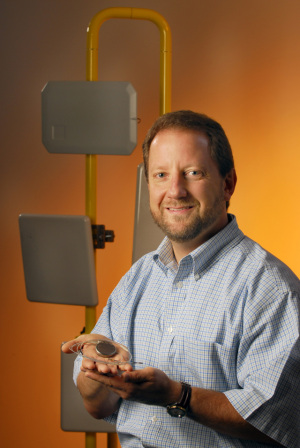by
Brendon Nafziger, DOTmed News Associate Editor | October 26, 2009

Implantable medical devices,
such as the one in the hand of
Ralph Herkert, director of GRTI's
Medical Device Testing Lab,
could receive interference
from RFID signals
The Georgia Tech Research Institute announced plans this month to test whether a common tracking system used in hospitals and warehouses interferes with medical devices.
The Atlanta-based applied research organization is developing protocols for its decade-old medical device testing lab to investigate the effect of radiofrequency identification (RFID) technology on implantable medical devices like defibrillators and pacemakers.
Although RFID is a ubiquitous technology that uses radio waves to track items in hospitals, stores and libraries to monitor inventory and prevent theft, nobody really knows if it has the potential to interfere with sensitive, and lifesaving, devices like implantable cardiac defibrillators (ICDs).




Ad Statistics
Times Displayed: 45175
Times Visited: 1385 Keep biomedical devices ready to go, so care teams can be ready to care for patients. GE HealthCare’s ReadySee™ helps overcome frustrations due to lack of network and device visibility, manual troubleshooting, and downtime.
"There's a potential there for interference," Ralph Herkert, director of GTRI's Medical Device Test Center, tells DOTmed News. "Basically, pacemakers and defibs are monitoring bodily functions, so they have sensing circuitry," he continues. "Any time you have sensing circuitry, you have the possibility for an interfering signal to get there."
Although no results have been published yet, Herkert says that early tests, coupled with preliminary findings from the FDA, suggest that low-frequency RFID systems have a much greater chance of interfering with implantable medical devices like ICDs, because their frequency is closer to the passband of the device.
"What an ICD is trying to sense is low-frequency events like heartbeats," Herkert says. "A heartbeat happens once a second, a one Hertz signal, if you will, so they have certain cutoff frequencies on their sensing circuitry." These tend to be quite low, he says, making them potentially vulnerable mainly to RFID signals in the lower range.
Torso simulator
Herkert tests the effects of RFID on devices by using what he calls a "torso simulator": a tank filled with saline solution that mimics the electrical characteristics of the human body. To test an implantable cardiac device from a manufacturer, he installs it and then exposes it to different frequencies and monitors any errors, inhibitions or changes in pacing. He can even inject cardiac simulator signals into the test to see if the device can pick up a heartbeat while distracted by select RFID interferences.
Worst-case scenario
Herkert believes the lab will be there to establish safe limits and discover worst-case scenarios, as he doesn't expect to find any cause for real alarm. "If there were a major problem it would have come to light already," he says, because many hospitals have already installed RFID systems so as to quickly find needed equipment.
Nonetheless, he believes testing is vital, as a worst case could be extremely bad. He gives as a hypothetical scenario, a patient who is pacemarker-dependent who passes through the security pillars while exiting a library: if the RFID signals in the pillars inhibit the device, the patient wouldn't know till his heart stops, and the pacemaker is unable to save him.
As for ICDs, while it's unlikely a patient will need defibrillation when exposed to RFID signals, there's a chance it could trigger an unintentional shock, Herkert says, where the device mistakes the interfering signal for the heart going into defibrillation, and delivers a painful jolt.
But Herkert expects he'll have a better grasp of the true extent of the problem in the next six months or so, when the testing protocols will be in place.

